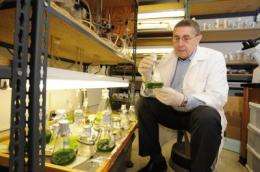Stacking traits in algae is focus of grant to Iowa State University researcher

Genetically stacking traits in corn in order to increase production, resist insects, improve standablity and many other characteristics is so common in agriculture that producers have come to expect it.
Some traits found in corn help it function as a better source for biofuels.
Lately, biofuels research has included a focus on using algae as a source for biofuels.
The problem is no one really understands the genomes of most algae well enough to consider the possibility of stacking traits to make them produce more oil, offer better thermal resistance or any of the other characteristics needed.
Martin Spalding hopes to change that.
With the help of a $4.37 million grant from the U.S. Department of Energy as part of the American Recovery and Reinvestment Act, Spalding intends to develop a micro-algal platform that will allow micro-algae to be treated as a crop.
Spalding, professor and chair of genetics, development and cell biology and a council member of Iowa State's Plant Sciences Institute, is working with the one type of alga, Chlamydomonas, that is already genetically mapped.
Martin Spalding is working on stacking traits in Chlamydomonas algae.
"We have a sequenced genome, we understand the metabolism, and we have the tools available to us to work with this alga," he said.
Currently, the micro-algae used in biofuels production are wild strains found in nature and have certain traits that growers like, such as high oil production.
"Using those algae is a good strategy," Spalding said. "But the limitation with that strategy is that it has no flexibility, because the algae can't be manipulated genetically.
"The advantage of using a genetically flexible alga like Chlamydomonas is that we can manipulate it in various ways to tailor it to what the needs are," he said.
"Rather than look for an alga that produces trait 'x' or trait 'y' and then trying to adapt each new strain to production, which is a very difficult process, we are manipulating Chlamydomonas to meet x and y."
Spalding said the best analogy would be to stacking traits in corn.
Farmers could plant simple, unmanipulated lines of corn that have high yield, he said. But you wouldn't get the drought tolerance you want.
You could plant drought-tolerant corn, but you wouldn't get standability. But by genetically manipulating the corn, you can get all the traits you need.
Spalding believes his three-year study will produce many desirable traits in Chlamydomonas alga.
"Our project will probably lead to increased production of basically vegetable oil that can be converted to biodiesel," Spalding said. "Using the same process we are using to increase that oil production, we also could divert the production into hydrocarbons, which are closer to petroleum."
The end result could have several benefits.
"It will mean we will have a more sustainable source (of biofuels) than we have now -- more sustainable and more flexible," he said.
And since algae are not a feed source for animals, using algae for biofuels will not lead to higher commodity or food prices.
Provided by Iowa State University

















